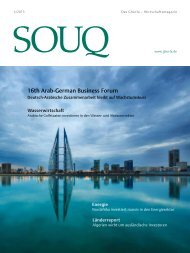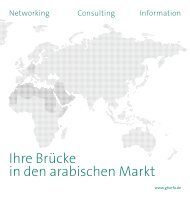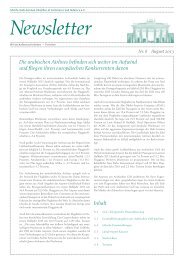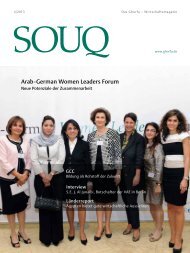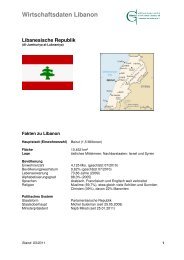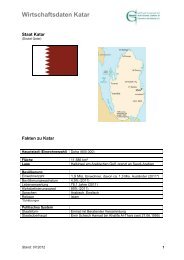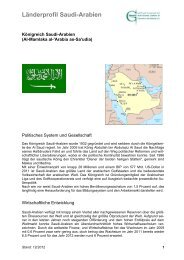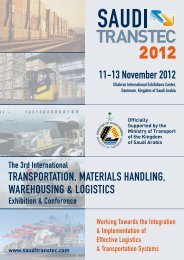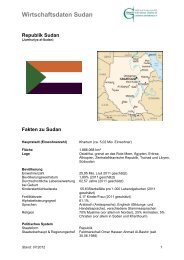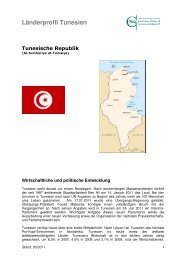Saudi-Arabien Wirtschaftshandbuch Saudi Arabia Business ... - Ghorfa
Saudi-Arabien Wirtschaftshandbuch Saudi Arabia Business ... - Ghorfa
Saudi-Arabien Wirtschaftshandbuch Saudi Arabia Business ... - Ghorfa
Erfolgreiche ePaper selbst erstellen
Machen Sie aus Ihren PDF Publikationen ein blätterbares Flipbook mit unserer einzigartigen Google optimierten e-Paper Software.
national commercial Bank, Jeddah<br />
38<br />
In recent years, the banks in <strong>Saudi</strong> <strong>Arabia</strong> have expanded<br />
their operations significantly. The deposits rose by 167%<br />
from 268 billion SR (end of 2000) to 717 billion SR at<br />
the end of 2007, whilst the credits during the same period<br />
rose by 342% from 174 billion SR to 595 billion SR. An<br />
important factor here is that the percentage of the loans<br />
granted to the private sector equated to 80% by the end<br />
of 2007. The main part of these loans were made up by<br />
consumer loans totalling 39%, almost half of which went<br />
toward financing vehicles. In the trade sector, 25% of the<br />
loans were used to finance imported goods whilst 8% of<br />
the loans were granted to the manufacturing industry and<br />
8% to the construction sector.<br />
The government has created five specialised credit institutes<br />
to cover the growing need of the private sectors and<br />
the state companies for long-term loans at favourable conditions.<br />
The <strong>Saudi</strong> Industrial Development Fund aims to<br />
promote private economic commitment in the industrial<br />
field. In 2006, 29% of the loans granted by the specialised<br />
institutes were used for this purpose. The Public Investment<br />
Fund, which made up 18% of these loans, supports<br />
the financing of commercial projects by the government<br />
and public institutes. The Real Estate Development Fund<br />
offers <strong>Saudi</strong> citizens an interest-free loan for building<br />
homes, offices or commercial buildings; its percentage of<br />
the loans from this institute totalled 39%. 7% went to the<br />
<strong>Saudi</strong> <strong>Arabia</strong>n Agricultural Bank, which provides financial<br />
resources for private and public agricultural projects<br />
and 7% of the loans of the specialised financial institutes<br />
went to the <strong>Saudi</strong> Credit Bank. All the named financial<br />
institutes play an important role in promoting the private<br />
sector and the further diversification of the country’s economic<br />
base.<br />
The <strong>Saudi</strong> <strong>Arabia</strong>n stock exchange is one of the largest in<br />
the Middle East. It was formally founded in 1984 when<br />
the <strong>Saudi</strong> Share Registration Company was formed after<br />
many new public companies were founded in the 1970s<br />
and shares were being traded informally. Today, the stock<br />
market is regulated by a committee whose members also<br />
include the Minister for Finance, the Minister for Trade<br />
and the Governor of the Central Bank (SAMA).<br />
The <strong>Saudi</strong> <strong>Arabia</strong>n stock exchange has continuously<br />
grown. According to information provided by the Arab<br />
Monetary Fund, it leads in the Arab world according<br />
to the listed stocks, the number of traded shares and the<br />
generated turnover. The capitalisation of the <strong>Saudi</strong> stock<br />
exchange is around 50% of the value of all Arab stock<br />
exchanges together. The share index of the <strong>Saudi</strong> stock<br />
exchange (1985 = 1,000) rose from 2,028.5 points (1999)<br />
to 8,206.2 points (2004). By the end of 2005, the index<br />
had risen to 16,712.6. After this overheating of the stock<br />
market, the index dropped by 52.5% to 7,933.3 in 2006<br />
thus achieving a normal course level on the stock market<br />
again. The stock market remained calm until the end of<br />
September 2007 (Index: 7.833,4 point) after which the<br />
index rose significantly to 11,176.0 (by the end of December<br />
2007).<br />
During the period 2000 to 2006, the number of shares<br />
traded on the stock exchange rose from 2,774 million to<br />
68,515 million and accordingly the value rose from 65.3<br />
billion SR to 5,261.8 billion SR. This trend continued<br />
even in 2007. The main factors for the enormous increase<br />
in the stock exchange transactions lie in the ongoing<br />
economic growth, the increased corporate profits, in<br />
the growing number of investors and a growing return of<br />
capital that had previously been invested abroad and the<br />
politico-economic reforms.



